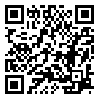Volume 20, Issue 4 (11-2021)
TB 2021, 20(4): 94-104 |
Back to browse issues page
Download citation:
BibTeX | RIS | EndNote | Medlars | ProCite | Reference Manager | RefWorks
Send citation to:



BibTeX | RIS | EndNote | Medlars | ProCite | Reference Manager | RefWorks
Send citation to:
HakimzadehArdakani A, Fallah M H, Vaziri S, Asi Moznab A. Design and Validation of Quranic-Narrative Model of Hope Therapy with Integrated Monotheistic Treatment Approach. TB 2021; 20 (4) :94-104
URL: http://tbj.ssu.ac.ir/article-1-3280-en.html
URL: http://tbj.ssu.ac.ir/article-1-3280-en.html
Abstract: (1529 Views)
Introduction: In the Holy Quran, hope, especially hope for the future, has been addressed many times and in different ways. In general, the study of the concept of hope shows that in any case, hope means expecting to achieve the goal accompanied by effort. In recent years, to achieve such a goal, especially in Iran, integrated monotheistic therapy has been used. The aim of this study was to design and validate the Quranic-narrative model of hope therapy with an integrated monotheistic treatment approach.
Methods: This is an exploratory, combined-method study (qualitative and quantitative) .The statistical sample in qualitative section consisted of 48 people who were selected by purposive sampling method, and in quantitative section, 313 people were selected by relative stratified sampling method. The research tool regarding the qualitative section , was a researcher-made questionnaire. In the process of the review of literature, hope in Qur'an and hadiths and psychological sources were studied, and the indicators of hope and hope therapy were extracted from this literature. Then, according to the integrated monotheistic treatment models, structures in the form of the treatment processes were defined for indicators. Finally, the appropriateness of the indicators with the structures ,and the structures with the stages of the existing models was measured. Free coding was used to analyze the qualitative part of the information and confirmatory factor analysis was used in the quantitative part of the exploratory factor analysis.
Results: The findings indicate the extraction of the Quranic-narrative model of hope therapy in 4 stages, 8 steps, 15 components and 75 items. Stages and components of the model are: Step 1) understanding the meaning and destination of monotheistic hope (expecting something desirable from God / benevolence from God / peace before God / desire for truth - otherworldly / worldly hope), step 2) determining the paths of monotheistic hope ( positive attitude to solving problems / understanding needs and desires / creating monotheistic behavior), step 3) giving meaning to monotheistic hope (strengthening faith and belief / performing rituals and prayers / hope to attract divine mercy and blessings / hope for piety and divine guidance) ,and step 4) integration of monotheistic belief and behavior (integration of belief and behavior).
Conclusion: Considering the appropriateness of hope therapy models and the model presented in this study, it can be said that the current model is effective in treating despair.
Keywords: Hope in Quran and Hadiths, Monotheistic Hope Therapy, Hope Therapy Model, Integrated Monotheistic Therapy
Type of Study: Research |
Subject:
Special
Received: 2021/05/16 | Accepted: 2021/07/4 | Published: 2021/11/1
Received: 2021/05/16 | Accepted: 2021/07/4 | Published: 2021/11/1
| Rights and permissions | |
 |
This work is licensed under a Creative Commons Attribution-NonCommercial 4.0 International License. |







